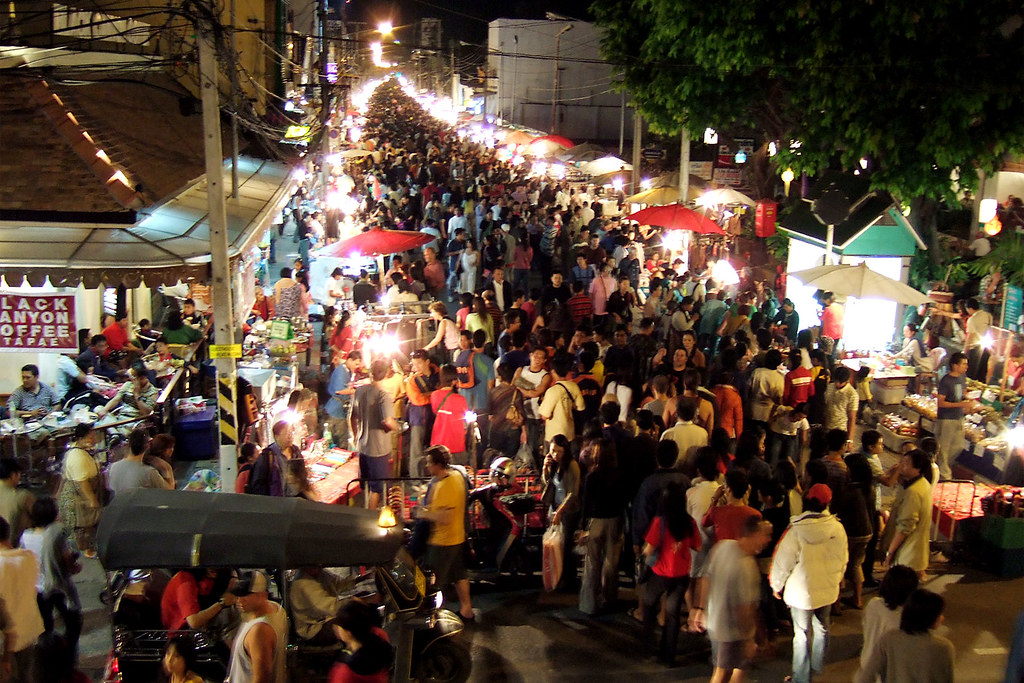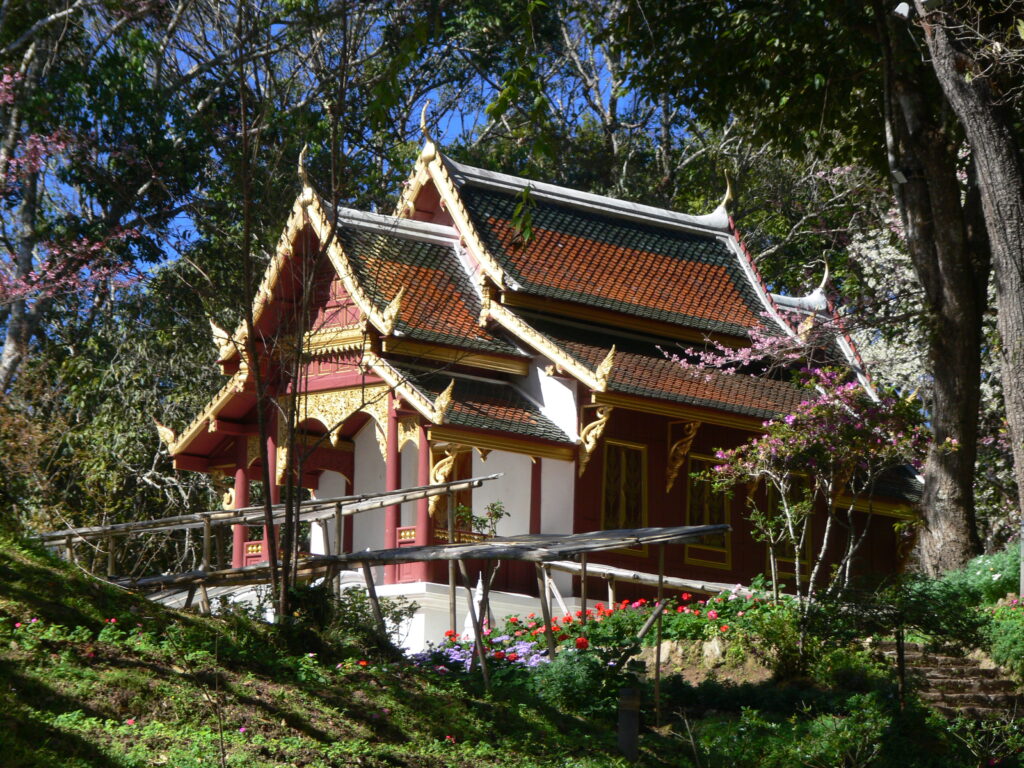Nestled in the mountainous region of Northern Thailand, Chiang Mai captivates visitors with its perfect blend of ancient traditions, natural beauty, and modern comforts. Often called the "Rose of the North," this cultural hub offers an authentic glimpse into Thailand's rich heritage while providing a refreshing alternative to the country's bustling beach destinations. This guide explores the best places to visit in Chiang Mai Thailand, from stunning temples and natural wonders to vibrant markets and unique cultural experiences.
If you're planning a trip with friends, Chiang Mai should be high on your list. Find more about exciting places in Thailand for group travel to round out your northern Thailand adventure.
Table of Contents
Why Chiang Mai Stands Out as Thailand's Cultural Capital?
Chiang Mai’s reputation as Thailand’s cultural capital is well-deserved, thanks to its rich heritage, centuries-old temples, vibrant festivals, and traditional crafts. When exploring the places to visit in Chiang Mai Thailand, travelers are immersed in a city where ancient traditions blend seamlessly with modern life. From the historic Old City walls to bustling night markets and serene mountain temples, Chiang Mai offers a unique cultural experience that sets it apart from other destinations in the country.
Its cultural significance is deeply rooted in its history as the former capital of the Lanna Kingdom, reflected in its over 300 ancient temples and vibrant traditions. According to the official Tourism Authority of Thailand website, the city offers visitors a unique glimpse into northern Thailand’s heritage, from the majestic Phra That Doi Suthep temple to lively markets showcasing local crafts and cuisine. This rich blend of history, spirituality, and living culture makes Chiang Mai a must-visit destination for those seeking authentic cultural experiences in Thailand.
What makes Chiang Mai special:
- Rich cultural heritage with over 300 temples
- Cooler climate than southern Thailand, especially from November to February
- Excellent value for accommodations, dining, and activities
- Gateway to northern Thailand's stunning mountain landscapes
- Vibrant art scene and traditional handicraft production
Top 10 Places to Visit in Chiang Mai Thailand
If you're wondering what to visit in Chiang Mai Thailand, this list of top 10 places covers everything from ancient temples to breathtaking natural wonders and unforgettable cultural experiences.
1. Wat Phra That Doi Suthep: Golden Mountain Temple

Perched on Doi Suthep mountain at 1,073 meters above sea level, this sacred temple is the most famous landmark in Chiang Mai. According to legend, a white elephant carrying Buddha relics climbed the mountain and trumpeted three times before dying, indicating the spot where the temple should be built.
What makes Doi Suthep special:
- Breathtaking golden chedi containing Buddha relics
- Spectacular panoramic views of Chiang Mai
- Fascinating Lanna architectural details
Visitor information: Open daily 6am-6pm. Entry fee: 30 THB for foreigners. Located 15km from the city center, accessible by songthaew (red truck taxi) for about 50 THB per person each way.
2. Old City Temples: Ancient Spiritual Sanctuaries

The historic Old City houses several of Chiang Mai's most significant temples. Each offers unique architectural features and spiritual significance.
Wat Phra Singh houses the revered Phra Singh Buddha image and features classic Lanna architecture with intricate woodcarvings and golden embellishments. Founded in the 14th century, it's one of the city's most important temples.
Wat Chedi Luang is home to a partially restored 15th-century chedi that once housed the famous Emerald Buddha (now in Bangkok). The massive structure remains impressive at 60 meters tall.
Wat Chiang Man, the oldest temple in Chiang Mai (built in 1296), contains two highly revered Buddha images: the crystal Phra Satang Man and the marble Phra Sila.
Temple highlights not to miss:
- Intricate wood carvings at Wat Phra Singh
- Massive ancient chedi at Wat Chedi Luang
- Historic Buddha images at Wat Chiang Man
Visitor information: Most temples open daily 6am-6pm. Entry fees range from free to 40 THB. Proper attire required (covered shoulders and knees).
3. Sunday Walking Street Market: Vibrant Shopping Experience

Every Sunday from late afternoon until midnight, Ratchadamnoen Road in the Old City transforms into a bustling pedestrian market featuring hundreds of vendors selling handicrafts, clothing, art, and delicious street food. This is one of the most popular places to visit in Chiang Mai Thailand for both tourists and locals.
Unlike typical tourist markets, Sunday Walking Street showcases authentic northern Thai craftsmanship with many items made by local artists and hill tribe communities.
What to experience at Sunday Walking Street:
- Handcrafted souvenirs and textiles from northern Thailand
- Traditional and contemporary art pieces
- Incredible variety of Thai street food
Visitor tip: Arrive early (around 4pm) to avoid the largest crowds. The market gets extremely busy from 6pm onwards. Bring small bills for easier transactions.
4. Doi Inthanon National Park: Thailand's Highest Peak

Often called "The Roof of Thailand," Doi Inthanon National Park encompasses the country's highest mountain at 2,565 meters above sea level. The park's varying elevations create diverse ecosystems, from tropical forests at lower levels to cloud forests near the summit, making it one of the most spectacular natural places to visit in Chiang Mai Thailand.
The park's attractions include stunning waterfalls (Mae Ya, Wachirathan, and Sirithan), hiking trails through pristine forests, and the beautiful Royal Twin Pagodas built to honor King Bhumibol and Queen Sirikit.
Highlights of Doi Inthanon:
- The summit with views and cool climate (often below 10°C in winter)
- Royal Twin Pagodas with spectacular gardens
- Multiple impressive waterfalls
Visitor information: Open daily 5am-6pm. Entry fee: 300 THB for foreigners. Located approximately 90km from Chiang Mai city, best visited on a day tour (800-1,500 THB per person) or by rental car.
5. Elephant Nature Park: Ethical Wildlife Encounter

While many places in Thailand offer elephant experiences, Elephant Nature Park stands out as a sanctuary focused on rescue and rehabilitation rather than entertainment. This ethical park provides a natural environment for elephants rescued from logging, street begging, and unethical tourism practices.
Visitors can observe elephants in a natural setting, learn about their behavior and conservation challenges, and participate in feeding and bathing activities without riding or performances.
What makes Elephant Nature Park special:
- Ethical elephant interaction without riding or forced behaviors
- Educational focus on elephant conservation
- Opportunity to participate in elephant care
Visitor information: Advance booking essential (often full weeks ahead). Full-day visit: 2,500 THB per adult including transport, lunch, and activities. Located approximately 60km from Chiang Mai city.
For travelers seeking authentic experiences in Thailand, exploring options for first-time visitors can help create the perfect itinerary combining Chiang Mai with other destinations.
6. Chiang Mai Night Bazaar: Evening Shopping Paradise

Every evening from dusk until around midnight, the area east of the Old City comes alive with one of Thailand's most famous markets. What began as a venue for Chinese merchants along the ancient trade route has evolved into a sprawling shopping destination covering several blocks.
Unlike the Sunday Walking Street's focus on handicrafts, the Night Bazaar offers everything from souvenirs and clothing to electronics and knock-off brands. Bargaining is expected and part of the experience.
What to find at the Night Bazaar:
- Traditional handicrafts and souvenirs
- Clothing, accessories, and textiles
- Street food vendors and food courts
Visitor tip: Prices usually start at 30-50% above what vendors will accept. Bargain with a smile and you'll often get better deals.
7. Bhubing Palace: Royal Mountain Retreat

This winter residence of the Thai royal family sits on Doi Buak Ha mountain, not far from Doi Suthep temple. When not in use by the royals (usually open January-March and August-October), the palace gardens are open to the public, showcasing spectacular roses, ornamental flowers, and landscaped grounds.
The palace, built in 1961, features Northern Thai architectural elements blended with contemporary design. While the royal living quarters are closed to visitors, the extensive grounds provide ample attractions.
Highlights of Bhubing Palace:
- Extensive rose gardens with various international species
- Stunning fern garden and water features
- Traditional Lanna-style royal residences (exterior view only)
Visitor information: Open 8:30am-4:30pm when the royal family is not in residence. Entry fee: 50 THB. Appropriate attire required (no shorts, sleeveless tops).
8. Wat Umong: Forest Temple with Ancient Tunnels

Unlike the ornate temples in the city center, Wat Umong offers a uniquely different spiritual experience. Built in the 14th century and nestled in the foothills west of the city, this "tunnel temple" features underground passages leading to small shrine rooms, built into a man-made mound.
The forested setting, complete with a small lake, walking paths, and meditation areas, creates a peaceful atmosphere away from the city's hustle. Ancient wall paintings, though faded, can still be seen in some tunnels.
What makes Wat Umong special:
- Unique ancient tunnels with Buddha shrines
- Peaceful forest setting ideal for meditation
- Interesting collection of damaged Buddha statues
Visitor information: Open daily 6am-5pm. Entry by donation (20 THB suggested). Located about 4km west of the Old City.
9. Warorot Market (Kad Luang): Local Culinary Adventure

For an authentic local shopping experience, head to Warorot Market near the Ping River. This three-story covered market serves primarily local shoppers rather than tourists, offering a glimpse into everyday Thai life and shopping habits.
The ground floor specializes in fresh food, flowers, spices, teas, and foodstuffs, while the upper floors feature clothing, textiles, and household goods. Adjacent Ton Lamyai Market focuses on wholesale flowers.
What to experience at Warorot Market:
- Authentic Thai culinary ingredients and local snacks
- Fresh tropical fruits and northern Thai specialties
- Traditional sweets and preserved foods
Visitor tip: Visit in the morning (before 11am) for the freshest food and most active atmosphere. Try local specialties like sai ua (northern Thai sausage) and nam prik ong (chili dip).
10. Chiang Mai Grand Canyon (Hang Dong Canyon): Swimming and Cliff Jumping

This former quarry has been transformed into a recreational area featuring crystal-clear blue waters surrounded by high red clay cliffs. Located about 30 minutes southwest of the city, it offers a refreshing escape from sightseeing, particularly during the hot season.
The main attraction is the large water-filled canyon with platforms for jumping and floating facilities for relaxation. The new Grand Canyon Water Park features inflatable obstacle courses.
Activities at the Grand Canyon:
- Swimming in clear blue waters
- Cliff jumping from various heights (at your own risk)
- Kayaking and paddleboarding
Visitor information: Open daily 8:30am-6pm. Entry fee: 50-100 THB for the natural canyon, 350-550 THB including water park activities. Located in Hang Dong district, approximately 20km from the city center.
Where to Stay in Chiang Mai Thailand?
To make the most of your visit, knowing where to stay in Chiang Mai Thailand is essential. Consider the following prime locations, each offering convenient access to the most notable places to visit in Chiang Mai Thailand and enriching your travel experience.
1. Old City: Heart of Historical Chiang Mai
The area within the ancient walls and moat offers easy walking access to major temples, Sunday Walking Street, and numerous restaurants and shops.
Ideal for: First-time visitors, temple enthusiasts, budget travelers Accommodation range: Budget guesthouses from 300 THB; mid-range boutique hotels from 1,000 THB.
2. Nimman (Nimmanhaemin): Trendy Modern District
This fashionable area northwest of the Old City is popular with expats and younger travelers for its coffee culture, design shops, and lively nightlife.
Ideal for: Trendy travelers, digital nomads, coffee enthusiasts and foodies Accommodation range: Modern hostels from 400 THB; stylish apartments from 1,500 THB.
3. Riverside: Relaxed Scenic Setting
The area along the Ping River offers a more relaxed atmosphere with upscale hotels, good restaurants, and easy access to the Night Bazaar.
Ideal for: Romantic getaways, those seeking quieter surroundings Accommodation range: Mid-range hotels from 1,500 THB; luxury riverside resorts from 3,500 THB.
Best Times to Visit Places in Chiang Mai Thailand
In the following sections, we will explore each season in detail to help you determine the best times to visit the top places to visit in Chiang Mai Thailand. Understanding the seasonal variations will ensure you have the most enjoyable and rewarding travel experience.
- Cool Season (November-February): The most popular time with comfortable temperatures (15-28°C), clear skies, and minimal rain. Perfect for temple visits and mountain trips. Major festivals include Loy Krathong/Yi Peng (November) and Flower Festival (February).
- Hot Season (March-May): Temperatures can reach 35-40°C. Morning temple visits and water-based activities are recommended. Songkran water festival in mid-April provides welcome relief from the heat.
- Rainy Season (June-October): Characterized by daily downpours, usually in the afternoon and evening. Mornings are often clear, and the countryside turns lush green. Waterfalls are at their most impressive.
Tip: If possible, schedule your visit during November-December to experience comfortable weather and the magical Yi Peng lantern festival, when thousands of paper lanterns are released into the night sky.
How to Get Around Chiang Mai?
Several transportation options are available to help you navigate Chiang Mai with ease. We’ll discuss these options to help you choose the best way to explore the many unique places to visit in Chiang Mai Thailand and enjoy the city’s vibrant culture and attractions.
Songthaews:
These red shared pickup trucks operate as informal bus routes. Flag one down, tell the driver your destination, and they'll nod if going that direction. Pay when you exit (30-40 THB within the city).
Tuk-tuks:
Three-wheeled taxis offer more direct service but cost more than songthaews. Always negotiate the fare before getting in, typically 80-150 THB for short trips.
Grab:
This ride-hailing app works well in Chiang Mai and often costs less than tuk-tuks for comparable trips.
Bicycle rental:
Many guesthouses offer bicycles for 50-100 THB per day. The flat Old City is ideal for cycling.
Motorcycle rental
Popular with visitors, small automatic scooters rent for 200-300 THB per day. International driving permit technically required.
Lesser-Known Places to Visit in Chiang Mai Thailand
While many travelers flock to the main attractions, there are also quieter, lesser-known places to visit in Chiang Mai Thailand that offer equally enriching experiences. Here are some of those hidden gems worth exploring.
1. Huay Tung Tao Lake
This reservoir at the base of Doi Suthep mountain features bamboo huts extending over the water where you can relax and enjoy fresh local food. Popular with local families but relatively unknown to tourists. Entry fee: 50 THB.
2. Wat Pha Lat
A tranquil temple hidden in the forest halfway up Doi Suthep, accessible via a moderate hiking trail called the "Monk's Trail" or by vehicle. Offers stunning views, peaceful surroundings, and few visitors.
3. Baan Kang Wat Artist Village
A creative community of studios, shops, and cafes in a garden setting west of the Old City. Local artists produce and sell handmade ceramics, textiles, and crafts.

Creating Your Perfect Chiang Mai Adventure
With its perfect balance of cultural exploration, natural beauty, and modern comforts, Chiang Mai offers visitors an authentic Thai experience distinct from the country's southern beach destinations. The best places to visit in Chiang Mai Thailand combine ancient traditions with contemporary creativity, set against a backdrop of mountain scenery and wrapped in the famous northern Thai hospitality.
Ready to explore the cultural treasures of Northern Thailand? Frenzy Holidays offers expertly crafted Thailand packages that include Chiang Mai's highlights along with other must-see destinations. Call +91 7400453140 today to speak with a Thailand specialist who can customize your perfect northern Thai adventure.
Places to Visit in Chiang Mai Thailand- FAQ's
How many days should I spend in Chiang Mai?
A minimum of 3 full days allows you to see the major attractions, though 5-7 days is ideal to explore at a relaxed pace and include day trips to surrounding areas.
Is Chiang Mai safe for tourists?
Chiang Mai is generally very safe, with low crime rates against tourists. Exercise normal precautions regarding belongings in crowded areas.
When is the lantern festival in Chiang Mai?
Yi Peng (lantern festival) coincides with Loy Krathong and usually occurs in November on the full moon of the 12th lunar month. Exact dates change each year.
Can I visit hill tribes from Chiang Mai?
Yes, various tour operators offer day trips and overnight stays with hill tribe villages. For more authentic experiences, choose operators that emphasize cultural exchange and sustainable tourism.
What is unique about Chiang Mai food?
Northern Thai cuisine differs significantly from central and southern Thai food. Regional specialties include khao soi (curry noodle soup), sai ua (herb-filled sausage), and nam prik ong (chili dip).
How do I get from Bangkok to Chiang Mai?
The most convenient option is flying (approximately 70 minutes, from 1,000 THB one-way). Overnight trains are popular for their comfort and scenery (12-14 hours, 800-1,500 THB depending on class).
What are the best markets in Chiang Mai?
Sunday Walking Street for handicrafts, Night Bazaar for evening shopping, and Warorot Market for authentic local food and produce. Each offers a different shopping experience.
Is Chiang Mai worth visiting during the burning season?
From late February through early April, agricultural burning causes poor air quality. If you have respiratory issues, it's advisable to visit during other months.
What's the best area to stay in Chiang Mai for first-time visitors?
The Old City is ideal for first-timers, offering easy walking access to major temples and attractions. Nimman area is better for those seeking trendy cafes and nightlife.
Do I need a visa to visit Chiang Mai?
Most nationalities receive 30-day visa exemptions upon arrival in Thailand. Check specific requirements for your country before traveling.

